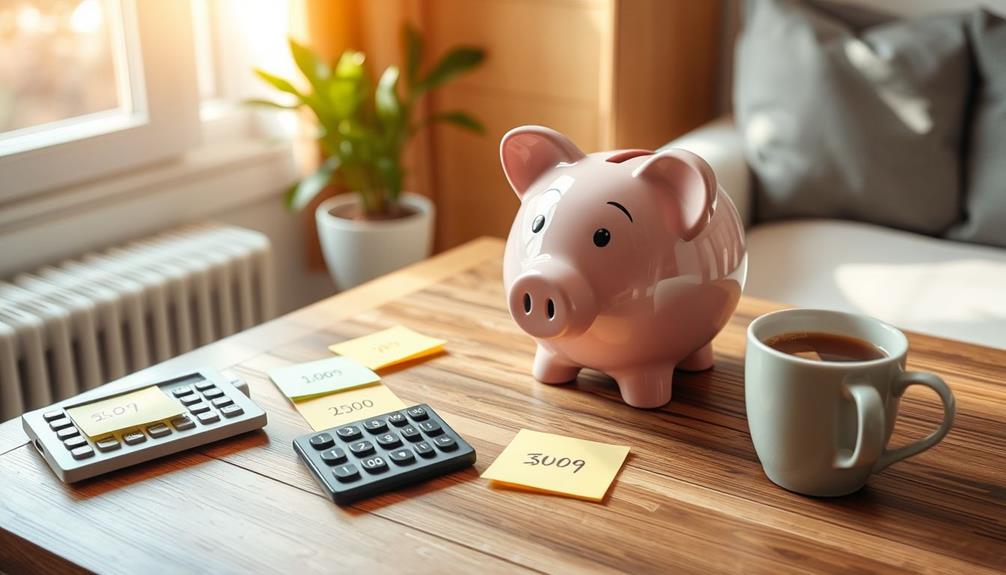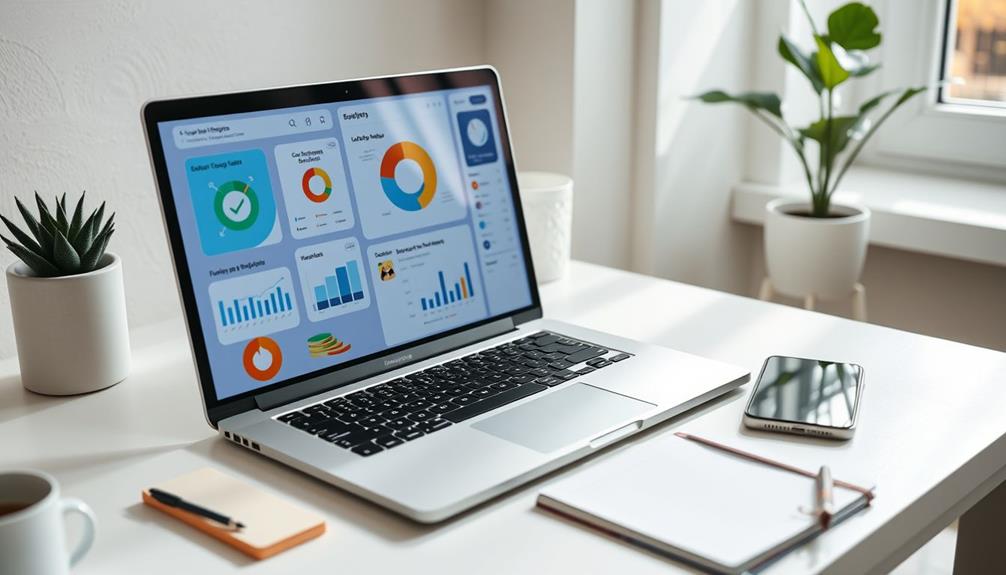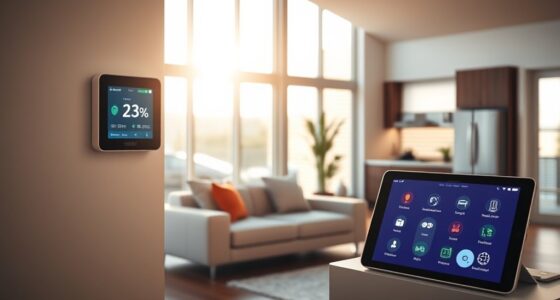Starting an emergency fund is essential for your financial security and peace of mind. Aim to save at least $500 as a starting goal, then gradually work towards three to six months' worth of living expenses. Create a budget to identify discretionary income for savings and automate contributions to a high-yield savings account to make it easier. Regularly monitor your progress and adjust your savings goals as needed. An emergency fund acts as a safety net against unexpected costs, preventing reliance on high-interest debt. Keep going, and you'll discover more effective strategies to bolster your financial resilience.
Key Takeaways
- An emergency fund serves as a cash reserve for unexpected expenses, aiming for three to six months' worth of living costs.
- Start with a realistic goal, such as saving $500, and gradually increase to cover larger financial shocks.
- Automate savings by setting up direct deposits or regular transfers to a high-yield savings account for consistent growth.
- Regularly review and adjust your savings goals based on changing financial circumstances to maintain adequate security.
- Having an emergency fund reduces reliance on high-interest debt, providing financial stability and peace of mind during crises.
Understanding Emergency Funds

Understanding the importance of your emergency fund is essential for financial stability. An emergency savings fund acts as a dedicated cash reserve for unplanned expenses, like medical bills or car repairs. Without this safety net, you might find yourself relying on credit cards or loans when unexpected expenses arise.
As the job market evolves, roles such as AI ethicist jobs become increasingly important, highlighting the need for financial security in uncertain times. Financial experts recommend having enough savings to cover three to six months' worth of living expenses. This buffer can make a significant difference during difficult times, such as job loss or unforeseen medical issues.
According to a Bankrate survey, less than half of Americans can cover a $1,000 emergency, underscoring the need to establish an emergency fund. The urgency to build this fund has increased, especially post-COVID-19, with 51% of Americans now prioritizing its establishment.
Importance of an Emergency Fund

The significance of an emergency fund can't be overstated; it's an essential pillar of financial security. With less than half of Americans able to cover a $1,000 emergency without turning to credit cards or loans, the reliance on debt can spiral out of control. An adequately funded emergency savings account can provide a buffer against unexpected financial emergencies like job loss, medical bills, or urgent home repairs.
Additionally, having a solid financial foundation allows individuals to explore other investment opportunities, such as a Bitcoin IRA, which can further enhance their financial stability.
Establishing an emergency fund greatly reduces financial stress. In fact, 51% of Americans now prioritize saving for unforeseen events, especially in the wake of the pandemic. Having this fund helps you avoid high-interest borrowing, which can damage your credit score and complicate your financial situation over time.
Moreover, an emergency fund not only meets immediate needs but also lets you concentrate on long-term financial goals and investments without disruption. By securing this safety net, you empower yourself to tackle life's uncertainties with confidence, knowing you have the resources to manage whatever comes your way.
Investing time in building an emergency fund is certainly a wise decision for your financial future.
Recommended Savings Amount

Building an emergency fund starts with knowing how much you should aim to save. The initial goal typically is to set aside at least $500 to cover minor unexpected expenses. This amount serves as a foundational safety net.
However, financial experts recommend aiming for three to six months' worth of living expenses for your emergency fund. This guarantees you're prepared for significant financial shocks, like job loss or medical emergencies. Additionally, having a diversified portfolio, including options like a Gold IRA, can provide financial resilience during economic downturns, making it easier to manage unexpected expenses in the long run diversification reduces overall investment risk.
According to a Bankrate survey, less than half of Americans can cover a $1,000 emergency, which underscores the importance of establishing a sufficient savings amount. If you're self-employed or have a variable income, consider targeting the higher end of that range. You might face income fluctuations and longer periods without pay, so a more substantial cushion is necessary.
It's also essential to regularly assess and adjust your targeted savings amount based on changes in your financial situation. Increased living costs or shifts in income can impact how much you need in your emergency fund.
Steps to Start Saving

Often, saving for an emergency fund can feel intimidating, but breaking it down into manageable steps makes it much easier. Start by setting a realistic savings goal. For instance, aim to save $500 as a starter fund to cover minor emergencies before working toward three to six months of living expenses for greater stability.
Consider utilizing cashback apps to save more effectively, as they can help you earn money while shopping, which can then be redirected to your emergency fund online savings opportunities.
Next, create a budget to identify your discretionary income. This'll help you determine how much you can regularly allocate to your emergency fund without straining your finances.
To make saving even simpler, automate your contributions by setting up direct deposits or automatic transfers to a high-yield savings account. This way, you can consistently add to your fund without the temptation to spend that money elsewhere.
Don't forget to monitor your progress regularly. This keeps you motivated and allows you to adjust your contributions based on any changes in your income or expenses.
Ultimately, if you ever need to dip into your emergency fund, remember to replenish it. Incorporate a structured repayment plan into your monthly budget to restore your financial safety net. This way, you'll stay prepared for whatever life throws your way.
Strategies for Building Your Fund

While saving for an emergency fund may seem challenging, implementing effective strategies can make the process smoother and more attainable. Start by setting a small initial savings goal, like $500, to cover minor emergencies. This goal will motivate you as you work towards a larger target of three to six months' worth of living expenses.
Additionally, adopting a holistic lifestyle approach, like managing stress effectively, can help free up mental and emotional resources to focus on your savings goals.
To maximize your savings potential, automate your contributions. Set up direct deposits or scheduled transfers to a separate high-yield savings account, allowing you to save automatically without manual effort.
Regularly review your budget to identify areas where you can cut discretionary spending. Redirect those funds toward your emergency fund, so you won't feel deprived.
When you receive financial windfalls, such as tax refunds or bonuses, consider putting those amounts into your emergency fund. This can greatly boost your savings progress.
Finally, monitor your emergency fund periodically to verify it meets your evolving financial needs. Adjust your contributions as necessary based on any changes in income or expenses.
Ideal Storage Options

When it comes to storing your emergency fund, choosing the right account can make all the difference. You'll want to prioritize liquidity and interest rates to guarantee your money works for you while remaining accessible when necessary. Here are some ideal storage options:
| Account Type | Interest Rates | Liquidity |
|---|---|---|
| High-Yield Savings | Higher than banks | High |
| Money Market Accounts | Competitive APY | Moderate to High |
| Certificates of Deposit | Varies with terms | Low (if laddered) |
| U.S. Treasury Bills | Typically higher | High (if held) |
High-yield savings accounts offer better interest rates and easy access, making them an excellent choice for emergency funds. Money market accounts provide higher APY and often include debit card access for added convenience. If you're considering certificates of deposit, employing a laddering strategy balances interest with liquidity. U.S. Treasury bills are secure and generally yield more than traditional savings accounts. Ultimately, you want to guarantee your emergency funds are in liquid accounts to avoid penalties or delays during urgent situations.
Maintaining Financial Resilience

To maintain financial resilience, you need to set clear savings goals and automate your contributions effectively. This is especially crucial as credit card debt in the U.S. surpassed $930 billion in 2020, highlighting the importance of having a financial safety net.
Setting Savings Goals
Creating a solid emergency fund is essential for your financial health, and setting achievable savings goals is the first step in that journey. Start by determining how much you want to set aside. A practical initial target could be $500, which can motivate you and provide a sense of accomplishment.
As you grow more comfortable with saving, aim for a long-term goal of three to six months' worth of living expenses. To guarantee you stay on track, it's important to utilize SMART criteria for setting your savings goals, as this method helps clarify your objectives.
To help you on this path, consider these tips for setting effective savings goals:
- Establish a clear target amount for your emergency fund.
- Break down your goals into smaller, manageable milestones.
- Regularly assess your income and living expenses.
- Adjust your savings goals as your financial situation changes.
- Celebrate small wins to maintain motivation.
Automating Contributions Effectively
Automating contributions to your emergency fund can transform your savings journey into a seamless habit. By setting up direct deposit from your paycheck, you guarantee that money goes straight to your savings without the temptation to spend it. You can also take advantage of mobile banking apps that round up your purchases, automatically transferring that spare change to your emergency fund.
Here's a quick look at how these strategies can impact your savings:
| Contribution Method | Emotional Impact |
|---|---|
| Direct Deposit | Peace of mind from knowing savings grow effortlessly |
| Round-Up Features | Joy in watching small change accumulate over time |
| Bi-Weekly Transfers | Confidence in regular savings aligning with income |
| Adjusting Contributions | Empowerment in taking control of your financial future |
Consistently contributing, even in small amounts, can lead to significant savings, especially with high-yield accounts. Establishing an automatic transfer on a set schedule makes it easier to prioritize your emergency fund, guaranteeing it's ready to cover three to six months of living expenses when needed.
Monitoring and Adjusting Strategies
Financial resilience hinges on your ability to monitor and adjust your emergency fund strategies regularly. By staying proactive, you can guarantee your savings align with your financial goals and changing circumstances.
A balanced approach to budgeting and spending can also support your overall wellness, much like maintaining a healthy lifestyle. Here are some effective ways to keep track:
- Regularly review your emergency fund balance and adjust for changes in living expenses and income stability.
- Track your spending habits to find areas where you can cut back and boost contributions to your emergency fund.
- Set specific timelines for replenishing your fund if you've had to dip into it, aiming to restore the balance swiftly.
- Use budgeting apps to monitor your financial progress, providing real-time insights for adjusting your savings strategies.
- Periodically reassess your target amount for your emergency fund, ideally three to six months of living expenses, to guarantee adequate financial security.
Frequently Asked Questions
Why Is It Important to Establish an Emergency Fund?
Establishing an emergency fund's essential because it shields you from financial shocks, like job loss or unexpected expenses. You'll avoid debt, maintain your investments, and gain peace of mind during uncertain times.
How Much Money Do You Need to Start an Emergency Fund?
You don't need a lot to start an emergency fund. Aiming for at least $500 is a good first step. Regularly contributing, even small amounts, will help you build it over time for unexpected expenses.
Why Is It Important to Save a Emergency Fund?
Oh sure, who needs a $500 safety net? Just plunge into debt like a pro! But seriously, having that cushion lets you tackle small crises without spiraling financially, keeping stress and sleepless nights at bay.
What Are the 3 Things Having an Emergency Fund Will Help You Save?
Having an emergency fund helps you save time, money, and stress. You won't scramble for quick cash, avoid high-interest debt, and stay financially stable during unexpected situations, allowing you to focus on your priorities.
Conclusion
Think of your emergency fund as a sturdy lifeboat in a stormy sea. When unexpected waves hit, you want a reliable vessel to keep you afloat. By starting your fund today, you're crafting that lifeboat, ensuring you won't sink when life gets turbulent. As you build it, you're reinforcing the hull, making it even stronger. So, set sail on this journey of financial resilience, and trust that your lifeboat will carry you safely through any storm.










